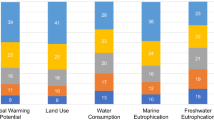Abstract
Most children in the UK are not eating enough fruit and vegetables to support optimum health. Evidence-based interventions are needed to change this trend. In the present pilot study, effectiveness of simple behavioural nudges on children’s lunchtime consumption of fruit and vegetables was tested in two primary (elementary) schools. Children’s (n = 107) lunchtime consumption was measured directly through the use of a validated digital photography protocol; measures were taken at baseline and again after a 3-week long intervention. Changes to the choice architecture of dining rooms included improved presentation and provision of target foods, attractive advertisements and labelling, and prompting by staff. For children who took school lunches (n = 67), both selection and consumption of fruit increased as the result of the intervention. Their selection of vegetables did not change over time, however, and their consumption ether remained unchanged or declined. No changes were observed in the comparison group (n = 40), who brought their lunch boxes from home. These results caution against using selection (serving sizes), as estimates of consumption or a measure of behaviour changes. They also show that all evaluations should consider the effects of each intervention on children’s eating overall, rather than just report changes in target item consumption, to check for any unintended consequences of the intervention.
This is a preview of subscription content, access via your institution
Access options
Subscribe to this journal
Receive 12 print issues and online access
$259.00 per year
only $21.58 per issue
Buy this article
- Purchase on Springer Link
- Instant access to full article PDF
Prices may be subject to local taxes which are calculated during checkout


Similar content being viewed by others
Data availability
Data files can be obtained by request from the authors.
References
WHO. Increasing fruit and vegetable consumption to reduce the risk of noncommunicable diseases. 2019. https://www.who.int/elena/titles/fruit_vegetables_ncds/en/. Accessed July 2019.
Cooke L. The importance of exposure for healthy eating in childhood: a review. J Hum Nutr Diet. 2007. https://doi.org/10.1111/j.1365-277X.2007.00804.x.
Krølner R, Rasmussen M, Brug J, Klepp KI, Wind M, Due P. Determinants of fruit and vegetable consumption among children and adolescents: a review of the literature. Part II: qualitative studies. Int J Behav Nutr Phys Act. 2011. https://doi.org/10.1186/1479-5868-8-112.
Marcano-Olivier M, Horne PJ, Viktor S, Erjavec M. Using nudges to promote healthy food choices in the school dining room: a systematic review of previous investigations. J Sch Health. 2019. https://doi.org/10.1111/josh.12861.
Cadario R, Chandon P. Which healthy eating nudges work best? A meta-analysis of field experiments. Mark Sci. 2019. https://doi.org/10.2139/ssrn.3090829.
Marcano-Olivier M, Pearson R, Ruparell A, Horne PJ, Viktor S, Erjavec M. A low-cost behavioural nudge and choice architecture intervention targeting school lunches increases children’s consumption of fruit: a cluster randomised trial. Int J Behav Nutr Phys Act. 2019. https://doi.org/10.1186/s12966-019-0773-x.
CDC. Progress on children eating more fruit, not vegetables. 2014. https://www.cdc.gov/vitalsigns/fruit-vegetables/index.html. Accessed July 2019.
Hanks A, Just D, Brumberg A. Marketing vegetables in elementary school cafeterias to increase uptake. Pediatrics. 2016. https://doi.org/10.1542/peds.2015-1720.
Marcano-Olivier M, Erjavec M, Horne PJ, Viktor S, Pearson R. Measuring lunchtime consumption in school cafeterias: a validation study of the use of digital photography. 2019. Public Health Nutr. https://doi.org/10.1017/S136898001900048X.
Elsbernd SL, Reicks MM, Mann TL, Redden JP, Mykerezi E, Vickers ZM. Serving vegetables first: a strategy to increase vegetable consumption in elementary school cafeterias. 2016. Appetite. https://doi.org/10.1016/j.appet.2015.09.001.
Acknowledgements
The authors would like to thank the catering teams, two schools who took part in the present study and postgraduate researchers who assisted in data collection.
Funding
This research was internally funded by Bangor University.
Author information
Authors and Affiliations
Contributions
ME designed the study, supervised the research, and wrote the paper; SW assisted with research procedures; SV advised on statistical analysis; MMO provided researcher training and analysed the data. All authors have read and approved the final paper.
Corresponding author
Ethics declarations
Conflict of interest
The authors declare that they have no conflict of interest.
Ethical approval
Approval to conduct this investigation was granted by the School of Psychology Ethics and Research Governance Committee at Bangor University.
Informed consent
Schools volunteered to take part and opt-out consent forms were distributed to participants at least 1 week prior to study commencement. Parents were informed that we shall photograph their children’s plates and lunch boxes. Additional fruit and veg provided at lunchtime were vetted for allergies.
Additional information
Publisher’s note Springer Nature remains neutral with regard to jurisdictional claims in published maps and institutional affiliations.
Rights and permissions
About this article
Cite this article
Erjavec, M., Williams, S., Viktor, S. et al. Nudge with caution: targeting fruit and vegetable consumption in primary schools. Eur J Clin Nutr 75, 724–727 (2021). https://doi.org/10.1038/s41430-020-00772-7
Received:
Revised:
Accepted:
Published:
Issue Date:
DOI: https://doi.org/10.1038/s41430-020-00772-7



